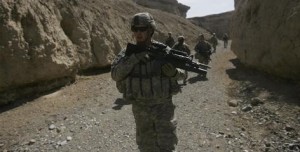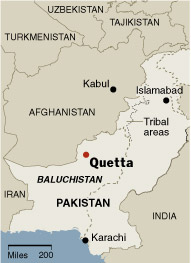The Problem with the New Afghanistan Strategy
BY Herschel Smith The 101st Airborne on patrol near Bagram Air Base, North of Kabul.
The 101st Airborne on patrol near Bagram Air Base, North of Kabul.
Regular readers of The Captain’s Journal know that we haven’t covered the missile strikes or supposed hits on high value targets (HVT) in either Afghanistan or Pakistan. This strategy, i.e., attacking mid- to high-level commanders in the hopes that the organization or ideology will disintegrate, is wasteful of time and resources.
Note that our objection has nothing to do with collateral damage, or the alleged benefit of these strikes to Taliban recruitment. We simply believe that the strategy will fail. And fail it has indeed, at least thus far. But it appears as if not only will the U.S. continue to engage in strikes to HVT, the program is set to expand into Quetta, Pakistan.
President Obama and his national security advisers are considering expanding the American covert war in Pakistan far beyond the unruly tribal areas to strike at a different center of Taliban power in Baluchistan, where top Taliban leaders are orchestrating attacks into southern Afghanistan.
According to senior administration officials, two of the high-level reports on Pakistan and Afghanistan that have been forwarded to the White House in recent weeks have called for broadening the target area to include a major insurgent sanctuary in and around the city of Quetta.
Mullah Muhammad Omar, who led the Taliban government that was ousted in the American-led invasion in 2001, has operated with near impunity out of the region for years, along with many of his deputies.
The extensive missile strikes being carried out by Central Intelligence Agency-operated drones have until now been limited to the tribal areas, and have never been extended into Baluchistan, a sprawling province that is under the authority of the central government, and which abuts the parts of southern Afghanistan where recent fighting has been the fiercest. Fear remains within the American government that extending the raids would worsen tensions. Pakistan complains that the strikes violate its sovereignty.
But some American officials say the missile strikes in the tribal areas have forced some leaders of the Taliban and Al Qaeda to flee south toward Quetta, making them more vulnerable. In separate reports, groups led by both Gen. David H. Petraeus, commander of American forces in the region, and Lt. Gen. Douglas E. Lute, a top White House official on Afghanistan, have recommended expanding American operations outside the tribal areas if Pakistan cannot root out the strengthening insurgency.
Many of Mr. Obama’s advisers are also urging him to sustain orders issued last summer by President George W. Bush to continue Predator drone attacks against a wider range of targets in the tribal areas. They also are recommending preserving the option to conduct cross-border ground actions, using C.I.A. and Special Operations commandos, as was done in September. Mr. Bush’s orders also named as targets a wide variety of insurgents seeking to topple Pakistan’s government. Mr. Obama has said little in public about how broadly he wants to pursue those groups.
Just to be clear because the New York Times is not, when they refer to the Taliban, they mean the original Afghanistan Taliban under the command of Mullah Mohammed Omar, not the Tehrik-i-Taliban (TTP) under various commands, most specifically Baitullah Mehsud. The TTP resides mostly in the FATA and NWFP (while they also send fighters into Afghanistan), while the Afghan Taliban fight in Afghanistan and seek safe haven and rest in and around Quetta, Pakistan.
We have previously discussed our principled objection to the centerpiece of the Afghanistan / Pakistan operation being cloak and dagger raids and missile strikes against HVT. It isn’t counterinsurgency; it’s counterterrorism. But a much more pragmatic objection is that it simply doesn’t work. It has been tried and failed now for more than six years. The new strategy of “more of the same” won’t work.
One reason that it has failed – although not by any stretch the only reason – is that it doesn’t really put the enemy on the defensive. That’s also the problem with the so-called negotiations that the current administration wants to pursue with the Taliban. The deluge of noise on negotiations convinces no one that the Taliban are actually being compelled to negotiate, and everyone that the U.S. is pining for the end of the fight.
Gareth Porter with the Asia Times succinctly explains why this strategy won’t work. “Jonathan Landay of McClatchy newspapers reported from Kabul on Sunday that experts on the Taliban express “serious doubts” about the splitting strategy, because insurgent leaders believe they are winning and the Hamid Karzai government is growing weaker.”
Recall that we’ve already discussed our opinion (The Coming Battle for Afghanistan) that Biden’s position that only 5% of the Taliban are incorrigible is simply daydreaming, and that in reality it is the indigenous poor that can be targeted for turning against the Taliban. But simply put, the switching of sides is not something that can be engineered. Force projection is necessary, and that for a protracted duration. The Afghans must see the U.S. as the stronger horse in the race.
As for Pakistan, there is happy talk about the reinstatement of previously sacked Supreme Court judges in Pakistan to their posts and what this means about the rule of law. The rule of law is disintegrating in Pakistan with the erstwhile Talibanization of the FATA and NWFP, and the ongoing Talibanization of Karachi, Lahore and Islamabad. Supreme Court judges are a side show.
Regarding the objection that the Taliban cannot be defeated unless their safe havens are ended in Pakistan, this complaint rings empty when the forces have not been committed to win the campaign in Afghanistan. The field is ripe for counterinsurgency in Afghanistan, and no HVT campaign in Pakistan will replace the need to do COIN in Afghanistan. Afghanistan first, then Pakistan as the campaign proceeds – and after the Pakistani Army and the Taliban see that we’re serious about the campaign.






No comments yet.
RSS feed for comments on this post. TrackBack URL
Leave a comment